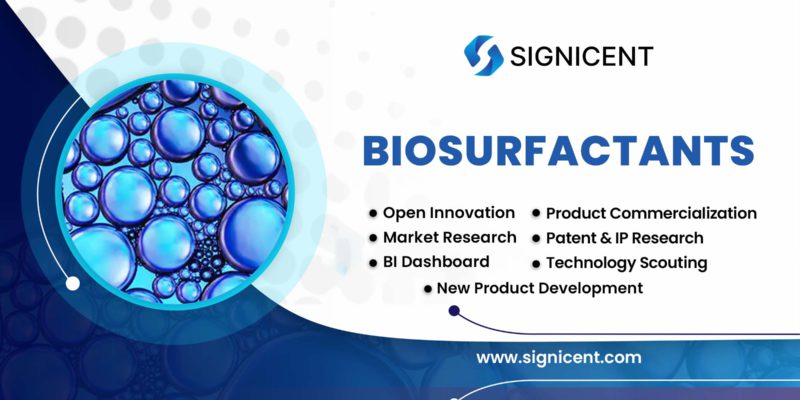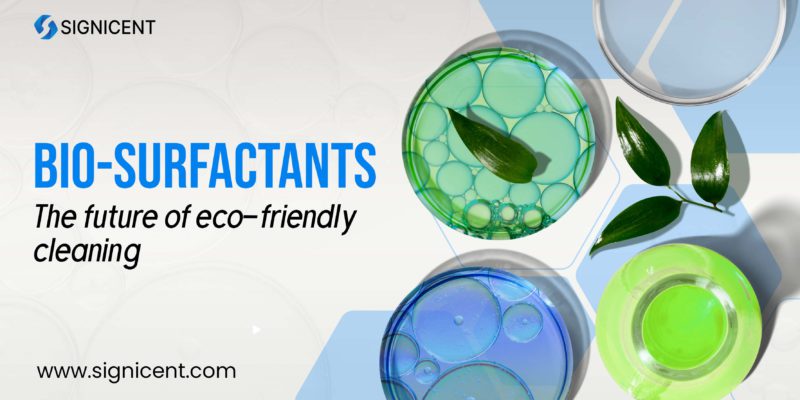The biosurfactants report talks about key challenges, solutions, patents, research, startups, key companies & market growth of biodegradable surfactants.
The chemical industry is steadily moving towards the development and production of biosurfactants. Biosurfactants are replacing conventional surfactants to lower their carbon footprint. An increasing amount of published patents on biosurfactants are observed in the last decade. When compared to traditional surfactants, biosurfactants are nontoxic and biodegradable making them excellent for applications in the environment, such as agriculture or water treatment.
Problem Associated With Conventional Surfactants
Surfactants contaminate the environment because of the widespread use of detergents and soap formulations, which are mainly non-biodegradable. Also, current analytical methods install a metal center by breaking a carbon-carbon bond and are limited to positions activated by thermodynamically weakened bonds or functional groups.
Emerging Solutions With Endless Possibilities
Using renewable feedstock or biodegradable raw materials and modifying them for use as a surfactant can be a viable solution for decreasing the burden on the environment. And, molecular skeleton restructuring transformations could be useful, for instance, in the deconstruction of polymers and identifying effective catalysts for the same process.
Innovations in Biodegradable Surfactants
Biodegradable surfactants from discarded plastics-l
R&D Group: Lowa State University and Ames Laboratory, USA (2021) have worked on long hydrocarbon chains of polymers. These were broken into shorter units with the introduction of aluminum end groups. These green organoaluminum species are easily derivatized into biodegradable fatty alcohols, carboxylic acids, or halides, providing high-value, end-of-first-life applications for the catenated chains of single-use polyolefins.
Composition
The first experiments employed Zr(CH2CMe3)2@SiAlOx (2.7 wt % Zr, 0.30 mmol Zr/g), which was prepared by grafting Zr(CH2CMe3)4 onto partially dehydroxylated silica-alumina (0.38 mmol SiOH/g; 9.3 wt % Al; 182 m2/g in pentane.
Advantage
Sustainable conversion of polyolefins into biodegradable, value-added fatty alcohols is done. The polyolefin deconstruction and heterofunctionalization reactions will enable the development of incipient plastic upcycling.
Process in brief
1. First, the polymer backbone and a surface-grafted alkyl or hydridozirconium species A react via methylene C–H bond activation to generate a midchain polymerylzirconium B.
2. Then, b-alkyl elimination from the midchain polymerylzirconium B results in carbon-carbon bond cleavage to give a terminal olefin and a new oligomerylzirconium species C.
3. Finally, chain transfer to aluminum occurs via heterobimetallic alkyl group metathesis of the alkylzirconium with an alkyl or hydridoaluminum species, and carboalumination or hydroalumination of the in situ generated olefin by AlR3 results in a new aluminum–carbon bond.
Conclusion
The combination of β-alkyl elimination and heterobimetallic alkyl group metathetical exchange at surface-immobilized organozirconium sites provides a valuable method to install reactive groups. Then the reconstruction of the carbon skeleton of organic molecules could be done without the need for prior activation or directing groups.
These catalytic reactions, as applied to polyolefins, are viable to compete with conventional syntheses of fatty alcohols. This process could motivate the recovery of discarded polyolefins from the environment, produce value-added chemical products, and offer environmentally friendly end-of-life for materials currently destined for landfills.
Each year Signicent provides consultancy to hundreds of organizations to help transform their innovations to value.
Bio-renewable amphiphilic polyester-based biodegradable surfactants
The production of a library of biodegradable surfactants derived from glycerol. Supercritical carbon dioxide (scCO2) is used to facilitate mild reaction conditions and allow the use of a lipase CaLB (Novozyme-435) as a chemo- and regioselective catalyst. It helps in yielding the linear and low molecular weight polymers desired to construct a range of surfactants.
The PEG-PGLSA surfactants gave higher CAC (critical aggregation concentration) values, likely due to the high hydrophilicity of PEG as an end-group. The results showed that the synthesized PGLSA-based surfactants can form self-assembled aggregates for personal care and cosmetic applications.
Bio-Surfactant from waste Cooking oil (WCO)
WCO is collected from Politeknik Kuching Sarawak and was filtered by using a separator funnel. Biosurfactant was synthesized using NaOH (Time- 60 mins, Temp- 70 degree Celsius, Conc- 1, 3, 5 M NaOH. The Biosurfactant was analyzed using Foamability test, pH test, oil emulsification, and hard water test. The utilization of waste cooking oil in this study is significant as the wasted cooking oil can be reused as a high-energy source for producing a high-value product like rhamnolipid. With the re-use of WCO directly, we can make our environment less polluted.
A technology landscape on biosurfactants was done and a comprehensive report on the biosurfactants is generated.
Partnership: Unilever and Evonik
Unilever plc is a multinational consumer goods company. Unilever is organized into three main divisions: Foods and Refreshments; Home Care; and Beauty & Personal Care.
Evonik is one of the world’s leading specialty chemicals companies. It operates through the following segments: Nutrition and Care, Resource Efficiency, Performance Materials, Services, and Other Operations.
Evonik, one of the world leaders in specialty chemicals and a market innovator for green biosurfactants used with household cleaning products, is proud to be enabling Unilever to achieve its goal of eliminating the use of fossil fuels in all of its cleaning brands by 2030. Evonik’s green biosurfactants are fermentation-made, highly effective, and 100% biodegradable. Under a collaboration announced in December last year, Evonik is commercializing its innovative class of green biosurfactants known as rhamnolipids for use with a range of Unilever’s household cleaning products.
Commercially Available Biosurfactants
Stepan Company (US) has STEPANQUAT Helia which is a modern hair conditioning agent that is better for hair as well as for the environment. It is a very mild, naturally-derived cationic surfactant ideally suited for hair conditioners and skincare products. The product is free from any animal products and preservatives.
Evonik Industries (Germany) has REWOFERM® SL ONE that shows an outstanding eco-toxicological profile. It is biodegradable under both aerobic and anaerobic conditions. The product has excellent cleaning performance and is environmentally compatible.
Clariant AG (Switzerland) has GlucoPure Foam that is a new generation of sugar surfactant based on coconut oil. Its superior foam and cleaning performance combined with highly sustainable content and no aqua toxicity label make it one of the best co-surfactants. Other benefits include no volatile organic compounds, mildness to skin.
Transforming Companies
Holiferm (2018), is a UK-based start-up that is ready to scale-up production of it’s biosurfactants made from virgin rapeseed oil and glucose. The ultimate goal of a startup is to have multiple plants around the world and scale a fully commercial product, with a low cost. The company had already developed two biosurfactants from renewable food-grade virgin rapeseed oil feedstocks via a natural energy separation fermentation process using yeast naturally found in honey.
Locus Performance Ingredients (2020) is a United States start-up that develops nature-derived, high-performance biosurfactant ingredients proven to outperform petrochemical surfactants and solve top challenges in personal care, home care, and industrial formulations. Their product formulations are safer, biodegradable, all-natural, and GMO-free biosurfactant ingredients that offer at least a 37% lower carbon footprint and 5-25X better performance, which results in much lower dosage rates.


